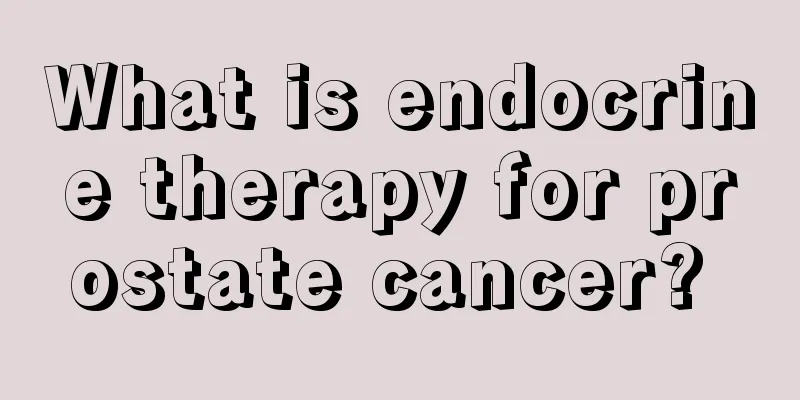What is endocrine therapy for prostate cancer?

|
As early as 1941, Huggins and Hodges discovered that surgical castration (surgical removal of both testicles to eliminate the source of testosterone) and estrogen can delay the progression of metastatic prostate cancer, and for the first time confirmed the responsiveness of prostate cancer to androgen removal. Prostate cells will undergo apoptosis in the absence of androgen stimulation. Any treatment that inhibits androgen activity can be called androgen removal therapy. reason The occurrence of prostate cancer is related to genetic factors. The relative risk of prostate cancer is 1, and if there is no prostate cancer in the family, the absolute risk is 8. The relative risk of hereditary prostate cancer is 5, and the absolute risk is 35 to 45. In addition, the incidence of prostate cancer is related to sexual life and eating habits. Men with active sex lives have a higher risk of prostate cancer. A high-fat diet is also related to the incidence. In addition, the incidence of prostate cancer may be related to race, region, and religion. Clinical manifestations Prostate cancer usually has no symptoms in its early stages. As the tumor progresses, the symptoms of prostate cancer can be summarized into two compressed categories: The gradual increase in prostatic urethral pressure can cause progressive dysuria, which is manifested as thin urine stream, short range, slow urine flow, interrupted urine flow, dripping after urination, insufficient urine volume, and labored urination. In addition, there are frequent urination, urgent urination, increased urine volume at night, and even urinary incontinence. Tumor compression of the rectum can cause difficulty in defecation or intestinal obstruction, compression of the vas deferens, resulting in insufficient ejaculation, and compression of nerves, resulting in perineal pain, which can radiate to the sciatic nerve. Metastatic symptoms Prostate cancer can invade the bladder, seminal vesicles, blood vessels and nerve bundles, causing hematuria, hematospermia, and impotence. Pelvic lymph node metastasis can cause edema of both lower limbs. Prostate cancer is often prone to bone metastasis, causing bone pain or pathological fractures and paraplegia. Prostate cancer can also invade the bone marrow, causing anemia or a decrease in the whole blood image. diagnosis The clinical diagnosis of prostate cancer mainly relies on rectal examination, serum PSA, transrectal prostate ultrasound and pelvic MRI. CT is less sensitive than MRI for the diagnosis of early prostate cancer. Due to the high rate of bone metastasis in prostate cancer, radionuclide bone scanning is often performed before treatment decisions. Prostate cancer is diagnosed by prostate biopsy. The malignancy of prostate cancer can be assessed by histological grading, of which the most commonly used is the Gleason scoring system. The malignancy of prostate cancer is divided into 2-10 points based on the sum of the scores of the primary and secondary structure areas in the prostate cancer tissue, where 1+1=the best 2 points and 5+5=the worst 10 points. Androgen removal is mainly achieved through the following strategies: ① Inhibition of testosterone secretion: surgical castration or medical castration (luteinizing hormone-releasing hormone analogs, LHRH-A); ② Blocking the binding of androgens to receptors: using anti-androgen drugs to competitively block the binding of androgens to androgen receptors on prostate cells. Other strategies include inhibiting the synthesis of adrenal androgens and inhibiting the conversion of testosterone to dihydrotestosterone. The recently developed and applied androgen biosynthesis inhibitor abiraterone acetate has added new drugs and treatment methods to endocrine therapy. At present, the main clinical endocrine treatment options include: ① simple castration (surgical or medical castration); ② single anti-androgen therapy (AAM); ③ androgen biosynthesis inhibitors; ④ maximum androgen blockade (MAB); ⑤ neoadjuvant endocrine therapy (NHT) before radical treatment; ⑥ intermittent endocrine therapy (IHT or IAD); ⑦ adjuvant endocrine therapy (AHT) after radical treatment. 1. Indications for endocrine therapy: (1) Metastatic prostate cancer, including N1 and M1 stages (castration, maximal androgen blockade). (2) Localized early-stage prostate cancer or locally advanced prostate cancer that cannot undergo radical prostatectomy or radiotherapy (castration, maximum androgen blockade, intermittent endocrine therapy). (3) Neoadjuvant endocrine therapy (castration, maximal androgen blockade) before radical prostatectomy or radical radiotherapy. (4) Adjuvant endocrine therapy (castration, maximum androgen blockade) in conjunction with radiotherapy. (5) Local recurrence after curative treatment, but local treatment is no longer possible (castration, maximum androgen blockade, intermittent endocrine therapy). (6) Distant metastasis after curative treatment (castration, maximal androgen blockade, intermittent endocrine therapy). (7) Continuous suppression of androgens during the castration-resistant period (castration, androgen biosynthesis inhibitors). (Note: Most prostate cancers are sensitive to castration therapy, but as the duration of endocrine therapy increases, prostate cancer will become insensitive to castration therapy, which is called castration resistance. At this time, continuous suppression of androgens is required for treatment) 2. Endocrine therapy: ① Castration 1) Surgical castration: Surgical castration, removal of both testicles, can cause testosterone to drop rapidly and continuously to extremely low levels (castration levels). The main adverse reaction is the psychological impact on the patient, so it is recommended that medical castration should be considered first if conditions permit. 2) Medical castration: Luteinizing hormone releasing hormone analog (LHRH-a) is a synthetic luteinizing hormone releasing hormone. The products on the market include: leuprorelin, goserelin, and triptorelin. The sustained-release dosage form is injected once every 1, 2, 3 or 6 months. After the injection of LHRH-a, the testosterone level gradually increases, reaching the highest point at 1 week (transient increase in testosterone), and then gradually decreases to reach the castration level at 3 to 4 weeks, but 10% of LHRH-a treated patients cannot reach the castration level in testosterone. LHRH-a has become one of the standard treatments for androgen removal. Since testosterone levels transiently increase when LHRH-a is first injected, anti-androgen drugs should be given 2 weeks before or on the day of injection and continue for 2 weeks after injection to counteract the flare-up caused by transient testosterone levels. LHRH-a should be used with caution in patients with spinal cord compression caused by bone metastasis, and surgical castration to rapidly reduce testosterone levels can be selected. 3) Estrogen: The mechanism of estrogen acting on the prostate includes: inhibiting the secretion of LHRH, inhibiting the activity of androgens, directly inhibiting the function of testicular Leydig cells, and direct toxicity to prostate cells. The most common estrogen is diethylstilbestrol, which can achieve the same effect as castration, but has a higher incidence of adverse cardiovascular reactions (increased incidence of coronary heart disease), so it should be used with caution. The tumor-related survival and progression-free survival rates of patients treated with surgical castration, medical castration or estrogen were basically the same. ②Antiandrogen Monotherapy (AAM) 1) Purpose: A single high-dose androgen receptor antagonist can inhibit the stimulatory effect of androgens on prostate cancer and the growth of androgen-dependent prostate cancer cells, and has almost no effect on the levels of serum testosterone and luteinizing hormone in patients. 2) Indications: Suitable for the treatment of patients with locally advanced prostate cancer without distant metastasis, i.e., stage T3-4NxM0. (3) Methods: It is recommended to use non-steroidal anti-androgen drugs, such as bicalutamide (Casodex) 150 mg orally once a day. (4) Results: There was no significant difference in overall survival compared with medical or surgical castration; moreover, during the medication period, the patient's sexual ability and physical fitness were significantly improved, and the incidence of cardiovascular disease and osteoporosis was reduced. ③ Androgen biosynthesis inhibitor treatment: After castration for prostate cancer, low levels of androgens still exist in the body. The prostate can also produce androgens. Abiraterone acetate inhibits the synthesis of androgens in testicular, adrenal and prostate cancer cells by inhibiting CYP-17, a key enzyme in the androgen synthesis pathway. It is currently used as the first-line treatment for mCRPC patients with no symptoms or mild symptoms, or symptomatic mCRPC patients who are not suitable for chemotherapy, as well as the first-line treatment for mCRPC patients with disease progression after chemotherapy. (m stands for metastasis, and CRPC refers to castration-resistant prostate cancer) ④Maximal androgen blockade (MAB) 1) Purpose: To simultaneously remove or block androgens from both testicular and adrenal sources. 2) Methods: The commonly used method is castration plus anti-androgen drugs. There are two main categories of anti-androgen drugs: one is steroid drugs, represented by megestrol acetate; the other is non-steroidal drugs, mainly bicalutamide (trade name: Casodex) and flutamide. 3) Results: Compared with castration alone, MAB combined with nonsteroidal anti-androgen drugs can prolong overall survival by 3-6 months and increase the average 5-year survival rate by 2.9%. For localized prostate cancer, the longer the MAB treatment, the lower the PSA recurrence rate. MAB treatment combined with bicalutamide can reduce the risk of death by 20% compared with castration alone, and can correspondingly prolong progression-free survival. ⑤ Neoadjuvant hormonal therapy (NHT) before radical surgery 1) Objective: To provide prostate cancer patients with endocrine therapy for a certain period of time before radical prostatectomy in order to reduce tumor size, clinical stage, and tumor-positive rate at the prostate resection margin, thereby improving survival rate. 2) Indications: Suitable for T2 and T3a stages. 3) Methods: MAB method using LHRH-a combined with anti-androgen drugs, or LHRH-a or anti-androgen drugs alone, but MAB method is more reliable. Neoadjuvant treatment time is 3 to 9 months. 4) Results: Neoadjuvant therapy may reduce the clinical stage of the tumor (for example, a decrease in clinical stage from T2c to T2a is called a decrease in clinical stage), reduce the positive surgical margin rate and lymph node infiltration rate, and reduce the local recurrence rate. Treatment longer than 3 months can prolong the PSA recurrence-free survival period, but has no significant improvement on the overall survival period. ⑥Intermittent endocrine therapy (IHT) Prostate cancer is often androgen-dependent. After a period of endocrine therapy, it gradually becomes independent of hormones, making endocrine therapy ineffective. However, if androgens are supplemented in a timely manner when androgens are absent or at low levels, the surviving prostate cancer cells will acquire anti-apoptotic properties and continue to grow, thereby prolonging the time it takes for the tumor to progress to the hormone-independent stage. The advantages of IHT include improving the patient's quality of life, reducing treatment costs, and possibly prolonging the tumor's dependence on androgens, which may have a survival advantage over traditional endocrine therapy. Clinical studies of IHT have shown that the patient's quality of life is significantly improved during the treatment interval (such as recovery of sexual desire, etc.). It can prolong the time that tumor cells rely on androgens without a significant negative impact on lesion progression or survival time. IHT is more suitable for localized lesions and those with local recurrence after treatment. 1) Treatment model of IHT: MAB method is often used, and medical castration (LHRH-a) can also be used, such as leuprorelin, goserelin, triptorelin, or cyproterone acetate (CPA). 2) Criteria for stopping treatment of IHT: The recommended discontinuation criteria in China is after PSA ≤ 0.2ng/ml, and continue for 3 to 6 months. 3) Criteria for restarting treatment after intermittent treatment: Currently, China recommends starting a new round of treatment when PSA>4ng/ml. 4) Indications for IHT: localized prostate cancer that cannot undergo radical surgery or radiotherapy; locally advanced patients (T3-T4); metastatic prostate cancer; positive pathological margins after radical surgery; recurrence after radical surgery or local radiotherapy. Those who are sensitive to endocrine therapy and whose PSA decreases to the standard for drug discontinuation after a certain period of endocrine therapy. ⑦Adjuvant hormonal therapy (AHT) for prostate cancer AHT refers to endocrine therapy after radical prostatectomy or radical radiotherapy. The purpose is to treat residual lesions at the resection margin, residual positive lymph nodes, and micro-metastatic lesions, and improve long-term survival rate. (1) Indications: ① positive pathological resection margin after radical surgery; ② positive lymph node (pN+) after surgery; ③ T3 (pT3) or ≤T2 with high-risk factors (Gleason>7, PSA>20ng/ml) confirmed by postoperative pathology; ④ AHT can be performed after radical radiotherapy for localized prostate cancer with the following high-risk factors (Gleason>7, PSA>20ng/ml); ⑤ AHT can be performed after radiotherapy for locally advanced prostate cancer. (2) Methods: ① Maximum androgen blockade (MAB); ② Medical or surgical castration; ③ Anti-androgen therapy (anti-androgens): including steroids and non-steroidal drugs. (3) Timing: Most advocate starting the therapy immediately after surgery or radiotherapy. According to foreign studies, the duration of adjuvant endocrine therapy for prostate cancer should be at least 18 months. |
<<: What are the 9 common types of lymphoma?
>>: What Chinese medicine can cure bile duct cancer
Recommend
How to set up the white dot?
Speaking of Apple phones, it can be said to be a ...
Will flat warts recur after laser treatment?
Flat warts are a very common skin disease. Many p...
Methods to slim waist, legs and whole body
Slimming waist, legs and whole body is the dream ...
What are the dangers of breast cancer
With the change of living environment, many women...
There are 5 symptoms of rheumatism in the body
Rheumatism is a common medical term in daily life...
What are the sequelae of hypoxic-ischemic encephalopathy
The direct harm of hypoxic-ischemic encephalopath...
Ear pain after tonsil surgery
Many people often suffer from tonsillitis. Althou...
How to clean removable dentures
Many people will install dentures after their tee...
Vibration hazards of eye massagers
Since the human eye is an important organ that de...
What are the early symptoms of skin cancer?
What are the early symptoms of skin cancer? Many ...
How long does the pain around the wound last after lung cancer surgery?
How long does the pain around the wound last afte...
What is below the left side of the belly button
Everyone has a belly button. Below our belly butt...
What should we pay attention to to prevent fungal food poisoning?
Whenever the rainy and humid season comes, wild m...
How to eat Cordyceps sinensis
When eating Cordyceps sinensis, it is best to eat...
Is glacial acetic acid poisonous?
People may not have heard of glacial acetic acid ...









